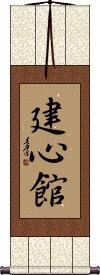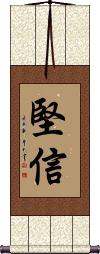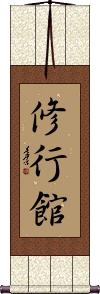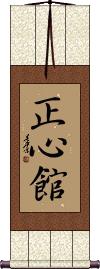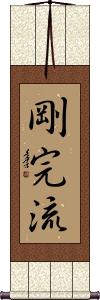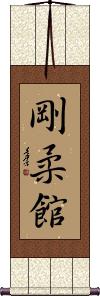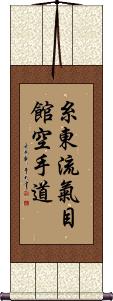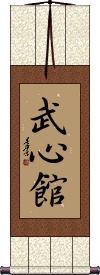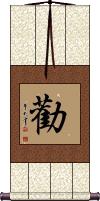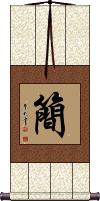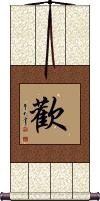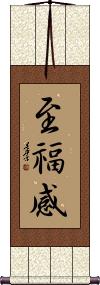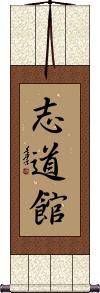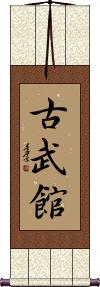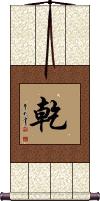Many custom options...
And formats...

The name Kenshin-Kan in Chinese / Japanese...
Buy a Kenshin-Kan calligraphy wall scroll here!
Personalize your custom “Kenshin-Kan” project by clicking the button next to your favorite “Kenshin-Kan” title below...
1. Kenshin-Kan
3. Shugyo-Kan
4. Seishin Kan
5. Go Kan Ryu
8. Shito-Ryu Ki-Me-Kan Karate-Do
9. Bushinkan
10. Encourage
11. Simplicity
12. Joyful
13. Bushidokan
14. Rurouni
15. Feeling of Bliss
16. Shidokan
17. Kobukan
19. Qian
Kenshin-Kan
Firm Belief / Strong Faith
Shugyo-Kan
Seishin Kan
Go Kan Ryu
Gojukan / Goju-Kan
Okinawan Goju-Kan
沖縄剛柔館 is the martial arts style Okinawan Gojukan or Okinawan Goju-Kan.
The meaning is “Okinawa hardness [and] softness hall.”
沖縄 = Okinawa.
剛 = Hard, firm, or strong.
柔 = Soft, softness, flexible, supple, yielding, gentleness, or pliant.
館 = Hall, building, school room, or an alternate word for a dojo.
Shito-Ryu Ki-Me-Kan Karate-Do
Bushinkan
Encourage
勸 is the simplest Chinese, Japanese Kanji, and old Korean Hanja word for encouragement or the act of encouraging someone.
This can also mean: to advise; to urge; to try to persuade; to exhort; to console; to soothe.
Simplicity
簡 expresses the idea of something simple or the essence of simplicity in life in Chinese.
This can also refer to a simple slip of bamboo for taking notes or writing a letter (especially in Korean Hanja).
Technically this is a word meaning simplicity and brevity in Japanese but it's rarely used in modern Japanese. Therefore, you should probably only select this character if your audience is Chinese.
See Also: Brevity
Joyful
歡 means joyous, happy, delightful, and pleased.
歡 represents external happiness that may have you clapping and cheering.
Please note: The other happiness/joyful which looks like "喜" is more popular.
歡 is the ancient/old version in China and Japan. After WWII in Japan, they started using 歓. Just let us know if you want this modern version instead of the ancient one.
See Also: Happiness
Bushidokan
Rurouni
Feeling of Bliss
Shidokan
Kobukan
Koushinkan / Koshinkan
孝心館 is the title for Koushinkan, Koshinkan, or Kōshin-Kan.
The romanization of this title varies a little, but the original characters are the same.
孝 = Filial piety or obedience.
心 = Heart, mind, intention, or center.
馆 = Building or establishment (dojo).
This can be pronounced in Chinese and has the same meaning, but you should consider this a Japanese martial arts title.
Qian
This can be the Chinese ancient surname Gan or current surname Qian. In Japanese, it can be the surname Nukui, Susumu, Ken, Kan, Kawaki, Kawai, Inute, or Inui.
The meaning of this character varies a lot depending on context. These meanings include dry, clean, foster, adoptive, heaven, male, masculine, enduring, or continual.
The “Gan” version of this character was converted to Simplified Chinese as 干 in 1965. However, the “Qian” pronunciation is not associated with 干. Though to add to the confusion, there is an unrelated Simplified Chinese character 千 that romanizes as “Qian” and is also a surname.
The Great Path has No Gate
大道無門 is a Buddhist proverb that means “The Great Way has no entrance,” “The Great Way is gateless,” or “The Great Path lacks a gate.”
This can be translated in many other ways.
This concept was authored within a long sacred text by 無門慧開 (known as Wúmén Huìkāi in Chinese or Mumon Ekai in Japanese). He was a Chinese Chan Master (in Japanese, a Zen Master) who lived between 1183 and 1260 AD. His most famous work was a 48-koan collection titled “The Gateless Barrier” or “The Gateless Gate” (無門關 Wú Mén Guān in Chinese, or 無門関 Mu Mon Kan in Japanese). This calligraphy title is a notable line from this collection.
I like this reference to the source of this proverb: The Gateless Gate 無門關
The following table may be helpful for those studying Chinese or Japanese...
| Title | Characters | Romaji (Romanized Japanese) | Various forms of Romanized Chinese | |
| Kenshin-Kan | 建心館 | ken shin kan kenshinkan | ||
| Firm Belief Strong Faith | 堅信 坚信 | ken shin / kenshin | jiān xìn / jian1 xin4 / jian xin / jianxin | chien hsin / chienhsin |
| Shugyo-Kan | 修行館 | shu gyou kan shugyoukan shu gyo kan | ||
| Seishin Kan | 正心館 | sei shin kan seishinkan | ||
| Go Kan Ryu | 剛完流 | gou kan ryuu goukanryuu go kan ryu | ||
| Gojukan Goju-Kan | 剛柔館 刚柔馆 | gou juu kan goujuukan go ju kan | ||
| Okinawan Goju-Kan | 沖縄剛柔館 沖縄刚柔馆 | okinawa gou juu kan okinawagoujuukan okinawa go ju kan | ||
| Shito-Ryu Ki-Me-Kan Karate-Do | 糸東流氣目館空手道 糸东流気目馆空手道 | shito-ryu ki-me-kan karate-dou shito-ryu ki-me-kan karate-do | mì dōng liú qì mù guǎn kōng shǒu dào mi4 dong1 liu2 qi4 mu4 guan3 kong1 shou3 dao4 mi dong liu qi mu guan kong shou dao | mi tung liu ch`i mu kuan k`ung shou tao mi tung liu chi mu kuan kung shou tao |
| Bushinkan | 武心館 | bu shin kan bushinkan | ||
| Encourage | 勸 劝 | kan | quàn / quan4 / quan | ch`üan / chüan |
| Simplicity | 簡 简 | kan | jiǎn / jian3 / jian | chien |
| Joyful | 歡 欢 / 歓 | kan | huān / huan1 / huan | |
| Bushidokan | 武士道館 武士道馆 | bu shi dou kan bushidoukan bu shi do kan | wǔ shì dào guǎn wu3 shi4 dao4 guan3 wu shi dao guan wushidaoguan | wu shih tao kuan wushihtaokuan |
| Rurouni | るろうに | ru ro-u ni / ruro-uni | ||
| Feeling of Bliss | 至福感 | shi fuku kan shifukukan | ||
| Shidokan | 志道館 | shi dou kan shidoukan shi do kan | ||
| Kobukan | 古武館 古武馆 | ko bu kan / kobukan | ||
| Koushinkan Koshinkan | 孝心館 孝心馆 | kou shin kan koushinkan ko shin kan | xiào xīn guǎn xiao4 xin1 guan3 xiao xin guan xiaoxinguan | hsiao hsin kuan hsiaohsinkuan |
| Qian | 乾 干 | ken | gān qián gan1 / qian2 gan / qian gan/qian | kan ch`ien kanchien kan chien |
| The Great Path has No Gate | 大道無門 大道无门 | dai dou mu mon daidoumumon dai do mu mon | dà dào wú mén da4 dao4 wu2 men2 da dao wu men dadaowumen | ta tao wu men tataowumen |
| In some entries above you will see that characters have different versions above and below a line. In these cases, the characters above the line are Traditional Chinese, while the ones below are Simplified Chinese. | ||||
Successful Chinese Character and Japanese Kanji calligraphy searches within the last few hours...
